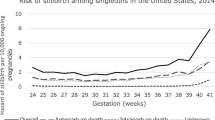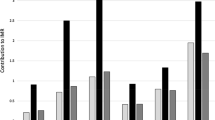Abstract
The purpose of this study is to explore state-level fetal death rates and <24 h infant mortality rates for deliveries less than 500 g in order to estimate outcomes classification differences at the edge of viability. We selected singleton deliveries to US resident mothers born <500 g and >20 weeks gestation from the NCHS live birth-infant death and fetal death files for 1999–2002 (n = 37,813). Infant deaths within 24 h of birth were selected to estimate odds of classification as a fetal death versus a live birth/infant death by state. Logistic regression was used to derive odds of classification as a fetal death and to adjust for maternal characteristics, calculating unadjusted and adjusted odds ratios. We identified 37,813 outcomes from 48 states reporting in this birthweight category. Unadjusted odds of classification of outcomes as a fetal death versus a live birth/death within 24 h by state ranged from OR = 0.38 (95% CI = 0.24–0.59) to OR = 2.93 (95% CI = 2.26–3.78); adjusted for maternal age and race, the range narrowed slightly to a OR = 0.31 (95% CI = 0.20–0.48) to aOR = 2.54 (95% CI = 1.96–3.30). Six states were more likely to classify outcomes as a live birth/infant death, while 14 states were more likely to classify as a fetal death, when compared to a large reference state. The remaining states did not differ significantly in their outcomes. The fraction of outcomes classified as fetal deaths varied by state during the years studied. This study suggests fetal death and early infant death outcomes reported for babies less than 500 g reflect differential classification thus influencing the validity of these vital statistics data at the state level. Further studies are needed to explore the factors that influence these differences.


Similar content being viewed by others
References
Lee, K. S., Khoshnood, B., Hsieh, H., Kim, B. I., Schreiber, M. D., & Mittendorf, R. (1995). Which birthweight groups contributed most to the overall reduction in the neonatal mortality rate in the United States from 1960 to 1986? Paediatric and Perinatal Epidemiology, 9(4), 420–430.
Martin, J. A., Kochanek, K. D., Strobino, D. M., Guyer, B., & MacDorman, M. F. (2005). Annual summary of vital statistics—2003. Pediatrics, 115(3), 619–634.
Hamilton, B. E., Minino, A. M., Martin, J. A., Kochanek, K. D., Strobino, D. M., & Guyer, B. (2007). Annual summary of vital statistics: 2005. Pediatrics, 119(2), 345–360.
Joseph, K. S., Kramer, M. S., Allen, A. C., Cyr, M., Fair, M., Ohlsson, A., et al. (2000). Gestational age- and birthweight-specific declines in infant mortality in Canada, 1985–94. Fetal and infant health study group of the canadian perinatal surveillance system. Paediatric and Perinatal Epidemiology, 14(4), 332–339.
Paul, D. A., Mackley, A., Locke, R. G., Stefano, J. L., & Kroelinger, C. (2009). State infant mortality: An ecologic study to determine modifiable risks and adjusted infant mortality rates. Maternal and Child Health Journal, 13(3), 343–348.
Centers for Disease Control and Prevention. (2004). Racial/ethnic trends in fetal mortality—United States, 1990–2000. MMWR Morbidity and Mortality Weekly Report, 53(24), 529–532.
MacDorman, M. F., Hoyert, D. L., Martin, J. A., Munson, M. L., & Hamilton, B. E. (2007). Fetal and perinatal mortality, United States, 2003. National Vital Statistics Reports, 55(6), 1–17.
MacDorman, M. F., Munson, M. L., & Kirmeyer, S. (2007). Fetal and perinatal mortality, United States, 2004. National vital statistics reports. Hyattsville, MD: National Center for Health Statistics.
MacDorman, M. F., & Kirmeyer, S. (2009). Fetal and perinatal mortality, United States, 2005. National Vital Statistics Reports, 57(8), 1–19.
Kochanek, K. D., & Martin, J. A. (2005). Supplemental analyses of recent trends in infant mortality. International Journal of Health Services, 35(1), 101–115.
Martin, J. A., Kung, H. C., Mathews, T. J., Hoyert, D. L., Strobino, D. M., Guyer, B., et al. (2008). Annual summary of vital statistics: 2006. Pediatrics, 121(4), 788–801.
Joseph, K. S., & Kramer, M. S. (1996). Recent trends in Canadian infant mortality rates: effect of changes in registration of live newborns weighing less than 500 g. CMAJ, 155(8), 1047–1052.
Joseph, K. S., & Kramer, M. S. (1997). Recent trends in infant mortality rates and proportions of low-birth-weight live births in Canada. Cmaj, 157(5), 535–541.
Phelan, S. T., Goldenberg, R., Alexander, G., & Cliver, S. P. (1998). Perinatal mortality and its relationship to the reporting of low-birthweight infants. American Journal of Public Health, 88(8), 1236–1239.
Alexander, G. R., Himes, J. H., Kaufman, R. B., Mor, J., & Kogan, M. (1996). A United States national reference for fetal growth. Obstetrics and Gynecology, 87(2), 163–168.
MacDorman, M. F., Martin, J. A., Mathews, T. J., Hoyert, D. L., & Ventura, S. J. (2005). Explaining the 2001–2002 infant mortality increase in the United States: Data from the linked birth/infant death data set. International Journal of Health Services, 35(3), 415–442.
Petersen, D. J., & Alexander, G. R. (1997). Threats to accurate interpretation of secondary data. In J. B. Kotch (Ed.), Maternal and child health: Programs, problems and policy in public health (pp. 395–404). Gaithersburg: Aspen Press.
Alexander, G. R., Petersen, D. J., Wingate, M. S., & Kirby, R. S. (2005). Research issues in maternal and child health. In J. B. Kotch (Ed.), Maternal and child health: Programs, problems and policy in public health (2nd ed., pp. 493–533). Sudbury: Jones and Bartlett.
Author information
Authors and Affiliations
Corresponding author
Additional information
This study was performed without any financial support.
Rights and permissions
About this article
Cite this article
Ehrenthal, D.B., Wingate, M.S. & Kirby, R.S. Variation by State in Outcomes Classification for Deliveries Less Than 500 g in the United States. Matern Child Health J 15, 42–48 (2011). https://doi.org/10.1007/s10995-010-0566-y
Published:
Issue Date:
DOI: https://doi.org/10.1007/s10995-010-0566-y




